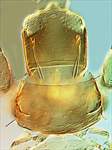Generic diagnosis
Small, bicoloured, sexually dimorphic, macropterous Phlaeothripinae. Head slightly longer than wide, weakly produced in front of eyes, with no long setae; mouth cone short, maxillary stylets retracted to eyes and wide apart with no maxillary bridge. Antennae 8-segmented, III with one sense cone, IV with 2 sense cones. Pronotum with only 2 pairs of prominent setae, anteroangulars and epimerals; notopleural sutures not developed. Prosternal basantra and mesopresternum well-developed; metathoracic sternopleural sutures absent. Fore wing slender, bicoloured, curved near base, without duplicated cilia. Pelta weakly sclerotised; tergites II–VI each with one pair of sigmoid wing-retaining setae; tube shorter than head. Male with fore tarsal tooth and fore femora with median tubercle; sternite VIII without pore plate, tergite IX setae S2 not different from female.
Nomenclatural data
Aleurodothrips Franklin, 1909: 228. Type species Cryptothrips fasciapennis Franklin 1908, by monotypy.
Only one species is known in this genus.
Australian species
Aleurodothrips fasciapennis (Franklin, 1908: 727)
Relationship data
The body structure of the only known species is unique, and the genus has no clear relationship to any other Phlaeothripinae.
Distribution data
Described originally from the West Indies, and with a synonym described from Queensland, this species occurs widely in warmer countries around the world
Biological data
This species lives as a predator on other small arthropods, particularly species of Coccoidea (Palmer & Mound 1990).
References
Okajima S (2006) The Insects of Japan Volume 2 The suborder Tubulifera (Thysanoptera). Fukuoka: Touka Shobo Co Ltd pp. 1–720.
Palmer JM & Mound LA (1990) Thysanoptera Chapter 22. 5: 67-76. In Rosen D [ed.] The Armoured Scale Insects, Their Biology, Natural Enemies and Control Vol B. Amsterdam.


